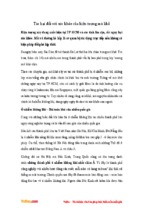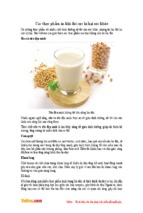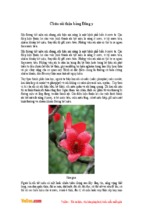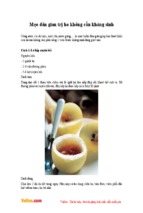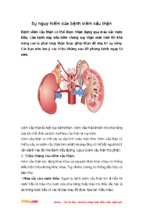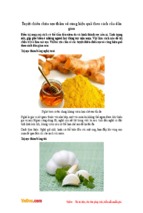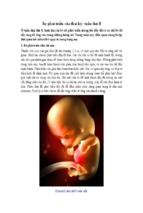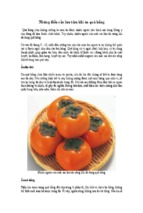View Article Online / Journal Homepage / Table of Contents for this issue
Plant Polyphenols (Vegetable Tannins*) : Gallic Acid Metabolism
E. Haslama and Y. Caib
aDepartmentof Chemistry, University of Sheffield, Sheffield S3 7HF
’Department of Pharmacognosy, The School of Pharmacy, University of L ondon, Brunswick Square,
London, W C I N IAX
(b) Molecular weights. Natural polyphenols encompass a
substantial molecular weight range from 500 to 3-4000.
Suggestions that polyphenolic metabolites occur which retain
the ability to act as tannins but possess molecular weights up to
20000 must be doubtful in view of the solubility proviso.
(c) Structure andpolyphenolic character. Polyphenols, per 1000
relative molecular mass, possess some 12-1 6 phenolic groups
and five to seven aromatic rings.
(d) Intermolecular complexation. Besides giving the usual
phenolic reactions they have the ability to precipitate some
alkaloids, gelatin, and other proteins from ~ o l u t i o n .These
~
complexation reactions are not only of intrinsic scientific
interest as studies in molecular recognition and possible
biological function, but also they have important and wideranging practical applications - in the manufacture of fashion
leathers, in foodstuffs and beverages, in herbal medicine, and in
chemical defence and pigmentation in plants.
(e) Structural characteristics. Plant polyphenols are based upon
two broad structural themes :(i) Galloyl and hexahydroxydiphenoyl esters and their derivatives. These metabolites are almost invariably found as
multiple esters with D-glucose2,4-11and a great many can be
envisaged as being derived from the key biosynthetic intermediate p- 1,2,3,4,6-pentagalloyl-~-glucose.Derivatives of
hexahydroxydiphenic acid are assumed to be formed by
oxidative coupling of vicinal galloyl ester groups in a galloyl Dglucose ester.
Gallic acid is most frequently encountered in plants in ester
form. These may be classified into several broad categories :
(1) Simple esters.
(2) Depside metabolites (syn-gallotannins).
(3) Hexahydroxydiphenoyl and dehydrohexahydroxydiphenoyl esters (syn-ellagitannins) based upon : (a) 4C1con-
Downloaded by University of Sussex on 21 December 2012
Published on 01 January 1994 on http://pubs.rsc.org | doi:10.1039/NP9941100041
1 Introduction
1.1
1.2
2
2.1
2.2
2.2.1
2.2.2
2.2.3
2.2.4
2.2.5
2.2.6
3
4
Properties and Classification
Isolation and Structure Elucidation
Biosynthesis
Secondary Metabolism
Biosynthesis of Gallic Acid and its Esters
Depside Metabolites
Hexahydroxydiphenoyl? Esters and Related
Metabolites
Oxidative Metabolism - Pathway (b)
Oxidative Metabolism - Pathway (c)
Oxidative Metabolism - Pathway (d) ‘Open-chain ’
Derivatives of D-Glucose
Comments and Conclusions
Epilogue
References
1 Introduction
Emil Fischer, at the turn of the century, made some
characteristically brilliant and perceptive contributions to the
study of the constitution of the gallotannins from Chinese and
Aleppo (Turkish) galls.’ His work, and that of Paul Karrer and
Karl Freudenberg, stimulated a great deal of interest amongst
chemists. These initial enthusiasms waned however as the great
complexity of many plant extracts (often natural, but frequently
induced by the many and varied post mortem processes required
to derive them) was realized. By the 1950s the topic had become
one of the dark impenetrable areas of Organic Chemistry. Its
renaissance coincided with the advent of new methods of
analysis and separation in the 1950s and the 1960s. Today the
composition of many plant extracts can usually be adequately
defined in terms of their polyphenolic (tannin) and simple
phenolic constituents. There is thus, for the first time, a firm
base from which to embark upon studies of the biological
properties of plant polyphenols and in particular their
complexation reactiom2 If there are exceptions to this
generalization then these relate to the polyphenolic metabolites
obtained from the wood and bark of trees. Here post mortem
events multiply the complexities of normal metabolism. As
a result the nature and total composition of many of
these commercially important polyphenolic extracts remain
uncertain.
OH
OH
Galloyl ester
I
1.1 Properties and Classification
It is now possible to describe in broad terms the nature of plant
polyphenols. They are secondary metabolites widely distributed
in various sectors of the higher plant kingdom. They are
distinguished by the following general features.
(a) Water solubility. Although when pure some plant polyphenols may be only sparingly soluble in water, in the natural
state polyphenol-polypheno1 interactions usually ensure some
minimal solubility in aqueous media.
-2H
OH
* Vegetable Tannins - because of its imprecision the authora has, over the past
25 years, sought to use this terminology as little as possible. However, like
original sin, it declines to disappear; hence its use in the title of this review.
t Hexahydroxydiphenoyl is used throughout this review as a convenient trivial
radical.
name for the 6,6’-dicarbonyl-2,2’,3,3’,4,4’-hexahydroxybiphenyl
OH
Hexahydroxydiphenoyl ester
41
Article Online
NATURAL PRODUCTView
REPORTS,
1994
42
H”
0
H’
HO
OH
y y o H
OH
6 = 6.97
Flavan-3-01olgomer unit
6 = 7.08
’
*
Downloaded by University of Sussex on 21 December 2012
Published on 01 January 1994 on http://pubs.rsc.org | doi:10.1039/NP9941100041
6,= 6.92
formation of D-glucose; (b) ‘C, conformation of D-glucose ;
(c) ‘ open-chain ’ derivatives of D-glUC0Se.
(4) ‘ Dimers ’ and ‘higher oligomers ’ formed by oxidative
coupling of ‘monomers’, principally those of class (3) above.
(ii) Condensed proan thocyanidins. The fundamental structural unit in this group is the phenolic flavan-3-01 (‘catechin’)
nucleus. Condensed proanthocyanidins exist as oligomers
(soluble), containing two to five or six ‘catechin’ units, and
polymers (insoluble). The flavan-3-01 units are linked principally through the 4 and the 8 positions.2 In most plant
tissues the polymers are of greatest quantitative significance but
there is also usually found a range of soluble molecular species
- monomers, dimers, trimers, etc.
Oligomeric condensed proanthocyanidins have been held
to be most commonly responsible for
(Bate-Smith et
the many distinctive properties of plants typically attributed to
‘condensed tannins ’. On the basis of solubility differences
Sir Robert and Lady Robinson14-l5 subdivided the leucoanthocyanins (condensed proanthocyanidins) into three classes :
(1) those that are insoluble in water and the usual organic
solvents or give only colloidal solutions.
(2) those readily soluble in water but not readily extracted
therefrom by means of ethyl acetate.
(3) those capable of extraction from aqueous solution by
ethyl acetate.
In so far as the total complement of condensed proanthocyanidins (procyanidins and prodelphinidins) found in
plant tissues is concerned the soluble oligomeric forms
(monomers, dimers, trimers ...) are, in metabolic terms, but the
‘tip of the iceberg’. According to the Robinsons’ classification
they represent category (3) above. For the generality of plants
it is quite clear that condensed proanthocyanidins, which fall
within the two other categories (1 and 2), invariably strongly
predominate over the more freely soluble forms. They are,
metaphorically speaking, the base of the ‘metabolic iceberg ’.
Indeed in the tissues of some plants such as ferns, and fruit such
as the persimmon (Diospyros kaki), there is an overwhelming
preponderance of these forms. They are also of frequent
occurrence in plant gums and exudates.
~
1
.
~
~
9
~
~
)
1.2 Isolation and Structure Elucidation
Real and substantial progress in the chemistry of the
proanthocyanidins began to be made in the 1960s following the
pioneering work of Weinges and his collaborators in
Heidelberg. 16, l 7 As techniques and strategies for the separation
and isolation of plant proanthocyanidins developed then so did
work on their structure, chemistry, and biosynthesis. These
researches have been regularly reviewed,2-18-20 particularly
since 1975; the most recent by Porter21in 1988. This last article
gives a detailed and comprehensive summary of flavans and
proanthocyanidins : nomenclature ; a comprehensive register
of plant sources and botanical distribution ; biosynthesis ;
biomimetic synthesis ; chemistry ; and conformational
characteristics. Other reviews which have recently been
published deal with chemical transformations and conformational features of this group.22-24Although such
statements are inevitably dangerous ones to make in science, it
is difficult not to conclude that this area has now become a
scientifically mature one.
The most spectacular recent advances in the chemistry and
biochemistry of plant polyphenols have undoubtedly been
=G
I
HO
\*.
OH
6‘= 6.94
‘6 = 7.02
Figure 1 Proton chemical shift values for the galloyl ester protons (*)
of p- 1,2,3,4,6-pentagalloyl-~-glucose
(D,O at 60 “C)
made2q4-11in the field defined by the first structural group - the
galloyl and hexahydroxydiphenoyl esters and their derivatives
-the most dramatic feature of which has been the increase,
by several orders of magnitude, of the number of known
compounds in this class, now well over 700. Much of this work
has emerged from two schools in Japan; those of Okuda in
Okayama and Nishioka in Fukuoka. Substantial progress has
been made possible by the application of new techniques of
isolation and analysis,’ i.e. MPLC and HPLC using Sephadex
gels, Toyo pearl (TSK HW-40), Diaion HP-20, Mitsubishi
MCI gel CHP-20P, reverse phase C-8 and C-18 supports,
centrifugal, partition, and droplet counter current
chromatography, etc. High resolution NMR spectroscopy has
provided a mine of structural information, and tables of
diagnostic ‘H and 13C chemical shift and coupling constant
data have been published.2v4.8q
25-29 Extensive use has been
made of the nuclear Overhauser effect but particular note
should be made of the use of IH--13C long range 2D NMR
spectra which provide specific information concerning the
orientation and location of different phenolic acyl groups, such
as galloyl, hexahydroxydiphenoyl, valoneoyl, dehydrodigalloyl,
sanguisorboyl, euphorbinoyl, trilloyl, chebuloyl, elaeocarpinusinoyl, on the polyol (usually D-glucose) core of the polyphenolic
e ~ t e r . ~ ’This
~ - ‘ ~technique is based on the ability to establish
connectivity between the aroyl proton(s) of an acyl group (*)
and the proton(s) at the position of acylation on the polyol
(usually D-glucose) core (m). This connectivity is established
via the three bond couplings of the two groups of proton(s) to
the ester carbonyl carbon atom (@, JCH 5 Hz).
The method has been fully described30 and permits, for
example, each of the five two-proton singlets associated with
each of the five galloyl ester groups of /?- 1,2,3,4,6-pentagalloylD-glucose to be defined, Figure 1. This type of information is
also of crucial importance for studies of the complexation of
polyphenolic esters with other
32, e.g. caffeine,
cyclodextrins, anthocyanins, peptides, and small proteins.
-
2 Biosynthesis
2.1 Secondary Metabolism
The distinctive features of gallic acid metabolism in higher
plants bear all the hallmarks of secondary metabolism. 33-36
Thus three prominent characteristics are :
(a) Structural diversity. At least 750 metabolites of gallic
acid, which fall within the remit of the description polyphenol
given above, have now been described. Despite their number,
the structures of the overwhelming majority of these metabolites
may be envisaged as being derived by chemical ‘embellishment
and embroidery ’ of one key intermediate : /?- 1,2,3,4,6-penta-Ogalloyl-D-glucopyranose.2 , 4, lo,11, 36 In this sense they bear a
very close analogy to other groups of secondary metabolites,
such as the various classes of terpenes and alkaloids, where
derivation from a common precursor is postulated.
(b) Accumulation and storage. Gallic acid containing
NATURAL PRODUCT REPORTS, 1994-E.
View Article Online
43
HASLAM AND Y. CAI
OH
OH
OH
R = H, (-)-Epigallocatechin
R = G, (-)-Epigallocatechin-3-Ogallate
R = H, (-)-Epicatechin
R = G, (-)-Epicatechin6-Ogallate
0
galloyl group, G = *m
Downloaded by University of Sussex on 21 December 2012
Published on 01 January 1994 on http://pubs.rsc.org | doi:10.1039/NP9941100041
OH
Shikimate Pathway
Phosphoenolpyrwate
+
13-Erythrose-4-phosphate
I
1
tico,
0f
i
O
H
OH
M1
?,
3-Dehydroshikimate
t
I
t
M2
f
~1,2,3,4,6-Pentagalloyl-~-glucose,
M
OH
Gallic acid, G-OH
L-Phenylalanine
Figure 2 Secondary metabolism - gallic acid: an idealized picture; M,, M,, M,, efc. - secondary metabolites derived from the key secondary
intermediate, /3- 1,2,3,4,6-pentagalloyl-~-glucose,
M
metabolites often accumulate in substantial quantities in plant
tissues. The apotheosis of this characteristic is the storage (up to
70% of the dry weight) of complex polyphenols of the
gallotannin class in Chinese galls (Rhus semialata). Similarly
the vegetative tissues of the green tea flush (Camellia sinensis)
may contain up to 25-30 YOof phenolic flavan-3-ols, prominent
amongst which are ( - )-epigallocatechin and ( - )-epicatechin
and their 3-gallate
(c) Taxonomic distribution. Gallic acid containing
metabolites are not universally distributed in higher plants.
They occur within clearly defined taxonomic limits in both
woody and herbaceous dicotyledons. l 3 Ellagitannins are widely
distributed in the lower Hamamelidae, Dilleniidae, and Rosidae
(the HDR complex) and have been used as prominent
chemotaxonomic markers. It has been suggested that the low
degree of diversification in gallate-dominated taxa may be a
result of the electron scavenging properties of these metabolites
which, in turn, inhibit oxidation, the most important reaction
in the biosynthesis of secondary metabolite^.^^
One extant theory34,36 suggests that secondary metabolism
provides organisms with a means of adjustment to changing
circumstances. The synthesis of enzymes designed to execute the
processes of secondary metabolism thus permits the network
of enzymes operative in primary/intermediary metabolism to
continue to function until such time as conditions are propitious
for renewed metabolic activity and growth. Within this
framework Bu'Lock and
formulated a sequence of
events which they envisaged would lead to the expression of
secondary metabolism : a termination of balanced growth,
leading to a sudden accumulation of intermediates in a primary
metabolic pathway, leading to the induced synthesis of
secondary metabolites.
,
In their idealized picture they suggested that a key secondary
metabolite (P) was first formed and then transformed by
secondary metabolic reactions to a diverse array of secondary
metabolites, P,, P,, P,, ..., P,. These reactions would not have a
high substrate specificity and their interplay in related
organisms would result in the production of characteristic
overlapping patterns of secondary metabolites. The biosynthesis of the myriad of gallic acid derivatives in plants
may be most readily comprehended within the compass of this
hypothetical sequence of events, Figure 2.
Article Online
NATURAL PRODUCT View
REPORTS,
1994
44
HO
OH
OH
Gallic acid G-OH
HHO O
q1
A
OH
UDP
Uridine diphosphate glucose
(UDP-glucose)
HHO O
a
,
OH
0-1-0Galloyl-D-glucose
(P-o-Glucogallin)
Downloaded by University of Sussex on 21 December 2012
Published on 01 January 1994 on http://pubs.rsc.org | doi:10.1039/NP9941100041
\
I
P- 1,2,3,4,6-Pentagalloyl-D-glucose
P-1,2,3,6-Tetragalloyl-D-glucose
Figure 3 Biosynthesis of p- 1,2,3,4,6-pentagalloyl-~-glucose;
P-D-glucogallin as galloyl group donor
enzyme from young oak leaves (EC 2.3.1 .90) catalyses the
2.2 Biosynthesis of Gallic Acid and its Esters
formation of P- 1,6-digalloyl-~-glucosefrom two molecules of
Gallic acid is unique amongst the various naturally occurring
P-glucogallin. The sequence continues in an analogous fashion,
hydroxybenzoic acids'l, 40 both in respect to its relative ubiquity
with P-glucogallin as prime galloyl donor, via P- 1,2,6-trigalloylin the plant kingdom and of the quantitative significance of its
D-glucose and P- 1,2,3,6-tetragalloyl-~-ghcose,to give finally Pmetabolism in many plants. Although some evidence exists to
I ,2,3,4,6-pentagalloyl-~-glucose,
Figure 3. One of the most
show that gallic acid may arise by oxidative degradation of
striking features of this biosynthetic pathway is that the
~-phenylalanine,~l
the weight of experimental data favours
sequence of esterification steps with gallic acid, 1-OH, then
the view that it is nevertheless formed primarily via the
6-OH, 2-OH, 3-OH, 4-OH, exactly parallels the sequence in the
Figure 2. In this
dehydrogenation of 3-dehydro~hikimate,~~-~~
chemically mediated esterification of the hydroxyl groups of Dcontext, and that of Bu'lock and Powell's general h y p o t h e s i ~ , ~ ~ glucopyranose. 53
observations made with genetically engineered strains of
This ~-D-glUCOgallindependent pathway is however by no
Escherichia ~ o l i46~ are
~ . significant. These demonstrate that
means exclusive. Studies with enzyme extracts of sumach (Rhus
under conditions of an artificially induced high carbon flux
typhina) have shown that, in addition to P-D-glucogallin, P- 1,6through the Shikimate pathway the organism responds by the
digalloyl-D-glucose, p- 1,2,6-trigalloyl-~-ghcose,and P- 1,2,3,6production of enzymes which act solely and specifically to
tetragalloyl-D-glucose may also act, although with progressively
remove excessive concentrations of the intermediate 3decreasing efficiency, as galloyl group donors (from the 1dehydroshikimate as they arise (in this instance as
position of the galloyl-ester), Figure 4.Thus two molecules of
protocatechuate and the P-ketoadipate pathway).
P- 1,6-digalloyl-~-glucosedisproportionate, Figure 4 (i), to give
P-Glucogallin (p-1-0-galloyl-D-glucose), first isolated from
p- 1,2,6-trigalloyl-~-glucose
and 6-O-galloyl-~-glucose; simiChinese rhubarb (Rheum oficinale) in 1903,47is, following the
larly P- 1,6-digalloyl-~-glucose may substitute for P-Dextensive studies of G ~ o s s , ~considered
~ - ~ ~ to be the key
glucogallin as galloyl group donor in the conversion of p- 1,2,6intermediate in the biosynthesis of esters of gallic acid. Work
trigalloyl-D-glucose to P- 1,2,3,6-tetragalloyl-D-glucose, Figure
with cell-free extracts from oak leaves, and subsequently with
4 (ii). Although alternative explanations are possible these
the partially purified glucosyl transferase, verified that
observations may have some bearing upon the observation
P-glucogallin is generated by the reaction of gallic acid with
(vide infra, Section 2.2.6) that many polygalloyl (and
UDP-glucose. Thereafter P-glucogallin undergoes a series of
hexahydroxydiphenoyl) esters of D-glucose are frequently found
further galloyl transfer reactions to yield ultimately P- 1,2,3,4,6in plant extracts in a form in which the anomeric hydroxyl
pentagalloyl-D-glucose. It is very interesting to note that
group is unacylated.
P-glucogallin acts as the principal galloyl-group donor in these
Strong circumstantial evidence now exists to support the
reactions. Thus in the first of these reactions a partially purified
proposition2-4 , lo.11*36 that the metabolite p- 1,2,3,4,6-penta-
View Article Online
45
HASLAM AND Y. CAI
NATURAL PRODUCT REPORTS, 1994-E.
p-1,6-DigalloyCD-glucose
,
HHO
(i)
o
';i;*
HHOO
g OG
G
o
G
OG
OH
p-1,6-Digalloyl-O-glucose
p-1,2,6-Trigalloyl-~-glucose
t,
HHOO
k
O
H
OH
Downloaded by University of Sussex on 21 December 2012
Published on 01 January 1994 on http://pubs.rsc.org | doi:10.1039/NP9941100041
6-Gallo yl-D-glucose
HHO O
a
a
OH
p-1,6-Digalloyl-o-glucose
I
p-1,2,6-Trigalloyl-D-glucose
;,
i
p-1,2,3,6-Tetragalloyl-D-glucose
FOG
HoHO
*OH
OH
6-Galloyl-D-glucose
Figure 4
Biosynthesis of galloyl esters of D-glucose: p- 1,6-digalloyl-~-glucoseas galloyl group donor
Pathway (d): Oxidative coupling;
ring opened -open chain derivatives
Pathway (b): Oxadative coupling;
Dehydrogenation,4-6and 2-3;
Oligomerizationby G O coupling
GGO
o*m
OG
~-1,2,3,4,6-Pentagalloy~-D-glucose
~Glucopyranose-~C~
conformation
/
J'
4
ococ
p-1,2,3,4,6-Pentagalloyl-D-glucose
D-Glucopyranose-'C4 conformation
Pathway (a): Additional galloyl
groups esterified as mdepsides
to the performedgalloyl glucose
I
J
-1%
Pathway (c): Oxadative coupling;
Dehydrogenation, 3-6, 1-6 and 2-4;
Dehydmhexahydmydiphenoylesters
Figure 5
Biogenesis of the gallotannins and ellagitannins ; the metabolic embellishment of ~-1,2,3,4,6-pentagalloy1-~-glucose,
principal pathways
galloyl-D-glucose, Figure 3, then plays a pivotal role, Figure 2,
in the formation of the vast majority of gallotannins and
ellagitannins which occur in many plants. Its biosynthetic
position is analogous to those of norlaudanosoline and
strictosidine in the formation of the benzylis~quinoline~~
and
the terpene-ind~le~~
alkaloids respectively. Four distinctive
and principal pathways, (a), (b), (c), and (d), are then presumed
to lead from /?-1,2,3,4,6-pentagalloyl-~-glucose
to give, by
appropriate chemical embellishment, the various classes of
metabolites, Figure 5.
Article Online
NATURAL PRODUCT View
REPORTS,
1994
46
n
0
lusitanica) yield a gallotannin in which additional galloyl
groups are linked as m-depsides to a mixture of p-1,2,3,4,6pentagalloyl-D-glucose
and
p- 1,2,3,6-tetragalloyl-~-gluC O S ~ . Likewise
~ ~ , ~ * the fruit pods of Caesalpinia spinosa give
and
a gallotannin based on a trigalloyl-quinic acid
similar polygalloyl esters have been isolated from Castanopsis
cuspidata and Acer saccharinum, respectively, which are based
upon shikimic acid59and 1,5-anhydro-~-glucitol.
Hofmann and GrossG1have very recently described enzymic
studies with extracts of Rhus typhina which begin to chart the
biosynthetic pathway from ~-1,2,3,4,6-pentagalloyl-~-glucose
to the gallotannins in sumach (mixtures of hexa-, hepta-, and
octagalloyl-D-glucose derivatives). Detailed ‘H and 13C NMR
analysis of the hexagalloyl-D-glucose fraction showed it to
contain at least three hexagalloyl esters in which additional
galloyl ester groups were linked as m-depsides to the galloyl
ester groups attached to C-2, (2-3, and C-4 of the Dglucopyranose ring.
27v
G=
HO
HO
6H
=G-G
O Y 0
‘
0
QOH
Downloaded by University of Sussex on 21 December 2012
Published on 01 January 1994 on http://pubs.rsc.org | doi:10.1039/NP9941100041
OH
Chinese gallotannin,tannic acid
OH
@OH
-2H
~
C02Me
___)
OH
HO
HO
;68v
;653
OH
OH
Methyl gallate
OH
2.2.2 Hexahydroxydiphenoyl Esters and Related Metabolites
In the thirty year period from 1950 to 1980 the Heidelberg
school of Otto Schmidt and Walter Mayer made distinguished
and seminal contributions to the study of naturally occurring
hexahydroxydiphenoyl e s t e r ~ . ~They
~ - ~ lisolated and identified
key metabolites such as corilagin 70-72 pedunculagin ;75
chebulinic and chebulagic acids 71, 73 dehydrodigallic,
valoneic, and brevifolin carboxylic acids ;66, 6 7 , 7 8 trilloic acid ;87
t e r ~ h e b i nand
~ ~ the dehydrohexahydroxydiphenoyl esters brevilagin 1 and 2 77 vescalin, castalin, vescalagin, and
castalagin ;*O, 8 3 * 8 5 ,8 8 . 91 punicalin and punicalagin ;** castavaloninic acid valolaginic acid and isovalolaginic acid.82In
addition, as the work progressed they continued to proVide62-64,6 9 , 7 9 , 9 2 an intellectually satisfying biogenetic rationale
for the derivation of this group of naturally occurring
polyphenolic esters (syn. ellagitannins). This pioneering work
has securely underpinned all subsequent developments in this
field, particularly the explosive increase in knowledge of the
past fifteen years which has resulted in the identification of
at least 500 discrete compounds in this class. The following
discussion does not attempt to be totally comprehensive, but
classifies the major groups of metabolites within a structural
and biogenetic framework.
Whilst there is, as yet, no formal experimental proof it is
generally assumed, following the hypo thesis enunciated by
Schmidt and M a ~ e r , ~92’ . that naturally
occurring
hexahydroxydiphenoyl esters and their derivatives are derived
by oxidative coupling of galloyl esters (with the formation of
new C-C and C-0 bonds) and oxidative and hydrolytic
aromatic ring fission. Support for the initial step in the putative
biogenetic scheme has been obtained by oxidation of methyl
gallate (potassium iodate,28 peroxidaseg3) to give dimethyl
hexahydroxydiphenoate. In the context of any consideration of
the range and chemical structure of metabolites now identified
in plant extracts (vide infra), it is important to note the lability
of dimethyl hexahydroxydiphenoate in aqueous media. Thus
the biphenyl ester is readily transformed to the highly insoluble
bis-lactone ellagic acid on standing in water. This transformation is undoubtedly facilitated by the proximal juxtaposition of the phenolic and ester groups on separate aromatic
nuclei and by free rotation about the biphenyl linkage.
Strong circumstantial evidence now also exists to suggest
that the vast majority of metabolites are derived biosynthetically, cf. Figure 5, (with subsequent possible
modifications in vivo by facile hydrolytic reactions), by oxidative
transformations of the key precursor /3- 1,2,3,4,6-pentagalloylD-glucose, following a scheme first put forward in 1982,4
Figure 6 .
In the ellagitannin metabolites now described, numerous
intramolecular ‘ C-C ’ linked ester groups have been located in
the ‘monomers ’ and similarly various intermolecular ‘ C-0 ’
linking ester groups have been defined in the formation of the
Dimethylhexahydroxydiphenoate
;76v
1
-2MeOH
OH
HO
OH
Ellagic acid
2.2.1 Depside Metabolites
The ability to metabolize depside derivatives of gallic acid
[Figure 5, pathway (a)] may be used as a guide to interrelationships in particular plant families55 and there is, on
present evidence, a close association of this form of metabolism
with the Rhoideae tribe in the Anacardiaceae. Many of the
products of this form of metabolism were often grouped
together in the earlier literature under the generic term
‘gallotannin’. The most common and familiar example is
Chinese gallotannin, or tannic acid, (galls, Rhus semialata),
which possesses the overall composition of a hepta- to
octagalloyl-P-D-glucose and in which, on average, two to three
additional galloyl groups are esterified in depside form to a preexisting p- 1,2,3,4,6-pentagalloyl-~-glucosecore. A novel
method of a n a l y s i ~ based
~ ~ , ~on
~ the use of HPLC and 13C
NMR reveals the full heterogeneity of the typical Chinese
gallotannin extract. This ranges from /3-pentagalloyl-D-glucose
itself to compounds with up to five or six additional galloyl
residues linked as m-depsides to this core. The proportion of
each type determines the final overall composition of the
gallotannin extract. Using 13C NMR the position of the
additional depside residues has been determined to be predominantly to the galloyl groups at C-2 or C-3, C-4 and C-6.
This polygalloyl-D-glucose is the most widely encountered
ester of this type found in plants,2~4~27
but others have also been
described. The galls of various oaks (Quercus infectoria, Q.
NATURAL PRODUCT REPORTS, 1994-E.
View Article Online
47
HASLAM AND Y. CAI
p-1,2,3,4,6-PentagalloyI-D-glucose
I
intramolecular
+I
GC coupling
hexahydroxydiphenoyl and dehydrohexahydroxydiphenoyl esters
('monomers')
1
intermolecular
GO coupling
[hexahydroxydiphenoyl and dehydrohexahydroxydiphenoyl esters],
('oligomers', n = 2,3,4)
Figure 6 Overall patterns of oxidative metabolism of
p- 1,2,3,4,6-pentagalloyl-D-glucose
in higher plants to yield ellagitannins4
Downloaded by University of Sussex on 21 December 2012
Published on 01 January 1994 on http://pubs.rsc.org | doi:10.1039/NP9941100041
OH
I
0
HO
co I
HO
HO
HO
HO
HO
OH
'
I
(R)-Hexahydroxydiphenoyl
Figure 7
(S)-Hexahydroxydiphenoyl
OH
OH
Flavogallonyl
Gallagyl
Ho&v
Principal derivatives of hexahydroxydiphenic acid formed by intramolecular C-C oxidative coupling
/ 0
'
OH
-OH
OH
3H
HO
0
Chebuloyl
I
0
Dehydrochebuloyl
?H
0
Dehydohexahydroxydiphenoyl
\c+
0
OH
-0c
OH
L-Ascorbic acid
OH
\
?
b
0
Brevifolyl
Trilloyl
Figure 9 Ester derivatives of hexahydroxydiphenic acid in which one
aromatic ring has undergone hydrolytic cleavage
Elaeocarpusinoyl
Figure 8 The dehydrohexahydroxydiphenoyl ester group and its
derivatives
oligomeric' structures. The principal members of these two
classes of ester group are shown in Figures 7 to 10.
In the intramolecular formation of a hexahydroxydiphenoyl
ester group the generation of a large-membered ring containing
two cis ( 2 )double bonds reduces conformational flexibility
4
and gives the molecule much greater rigidity. Where the
bridging occurs 1,6, 3,6, o r 2,4, the D-glucopyranose residue is
forced to adopt a thermodynamically unfavourable C,
conformation. One specific chirality is imposed upon the
hexahydroxydiphenoyl group as it is formed and this chirality
is determined by the need of the new ester group to bridge
particular positions in the polyol (usually D-glucose) portion of
the molecule. The absolute configuration of the twisted biphenyl
system in corilagin has been deterrnined9,sg5as (R)by relation
NPR 11
Article Online
NATURAL PRODUCTView
REPORTS,
1994
48
O
'
co
HO
I
H HO O OH W
OH
'/
OH
HO
occo
0
-
OH
I I
oc
I
OH
(S)-Sanguisotboyl
oc
I
/ \
oc co
I I
(S)-Valoneoyl
OH
OH
-
oc co
I I
I I
OH
-
(R)-Valoneoyl
\ /
I I
OH
@
-
DehydrodigalloyI
Downloaded by University of Sussex on 21 December 2012
Published on 01 January 1994 on http://pubs.rsc.org | doi:10.1039/NP9941100041
OH
W OH OOH H
I
HO$O@
I
L HOC
(R)-Macaranoyl
(R)-Tergalloyl
-OH
HO
OH
(R )-EuphorbinoyI
Figure 10 Principal ester groups formed by intermolecular C-0 oxidative coupling of galloyl and hexahydroxydiphenoyl esters
-2H
___)
bb-Galloyl ester
HO
OH OH
HO
Hexahydroxydiphenoylester
OH
MeOOMe OMe
OH
-
Me0 Me0 OMe OMe
M
e
O
Me02C
w
O
M
e
COfle
Dimethyl(R)-(+)-hexamethoxydiphenoate
Corilagin, G = galloyl
-
\-I
Ho Me Me
Schizandrin
95
Figure 11 Determination of the absolute configuration of ( + )-hexahydroxydiphenic acid in the metabolite corilaging4*
NATURAL PRODUCT REPORTS, 1994-E.
Gemin D
p-1,2,3,4,6-Pentagalloyl-D-glucose
PterocatyaninC
Tellimagrandin 2
(Eugeniin)
Strictinin
Downloaded by University of Sussex on 21 December 2012
Published on 01 January 1994 on http://pubs.rsc.org | doi:10.1039/NP9941100041
View Article Online
49
HASLAM AND Y. CAI
Sanguin H-4
Tellimagrandin 1
__..--Casuariitin
Potentillin
OH
Pedunculagin
HO
G=
G-G =
0
HO
(S)-Hexahydroxydphenyl
Galloyl
Figure 12 Principal ‘ monomeric’ hexahydroxydiphenoyl esters formed by oxidative coupling of vicinal galloyl ester groups in
conformation ; pathway (b)
pentagalloyl-wglucose ;
Table 1 Principal naturally occurring ‘monomeric ’ ( S ) hexahydroxydiphenoyl esters ; 4C, D-glucopyranose.
Structures - positions of esterification to the D-glucose core
Trivial name
Galloyl
Hexahydroxydiphenoyl
Ref.
Tellimagrandin I1
(Eugeniin)
Tellimagrandin I
Casuarictin
Potentillin
Pedunculagin
Gemin D
Strictinin
Heterophyllin A
Sanguin H-1
Sanguin H-4
Nobotanin D
Roxbin B
Pterocaryanin B
Pterocaryanin C
p- 1,2,3
4,6
97,99
233
496
2,3 :4,6
2,3 :4,6
2.3 :4.6
97
28,
lol
28, 102, 103
75, 104
105, 106
107
108
111
109, 110
112, 113
114
115
116
P-1
a-1
-
I
3
P-1
a-1,3
a1,6
a-1
P-176
-
4
B- 1,4,6
+ )-catechin derivatives
Stenophynin A
Stenophynin B
I8-8-C-(
-
6
2,3 :4,6
2,3
117
117
to the lignan schizandrin, Figure 11, and the chirality of other
hexahydroxydiphenoyl esters may be determined by measurements of circular dichroism (CD) and comparison with
corilagin. The C D spectra of hexahydroxydiphenoyl esters are
characterized by a distinctive couplet centred at 200-210 nm
with a positive or negative maximum at 228-238 nm. The AE
values are approximately incremental for the number of
hexahydroxydiphenoyl ester groups in the
94, 95 It is
of interest to note that the same conclusions regarding the
chirality of the hexahydroxydiphenoyl ester groups bound to
-
B- 1,2,3,4,6-
the D-glucopyranose core may be deduced from theoretical
considerations.4 , 28 These arguments also strongly suggest that
the absolute configuration of the hexahydroxydiphenoyl esters
is determined largely, if not solely, by the inbuilt stereochemistry of the sugar molecule.
The principal mode of transformation (Figure 5, pathway
(a)) is by oxidative C-C coupling of galloyl ester groups (4-6
and 2-3) in the thermodynamically most stable
confollowed by
formation of p- 1,2,3,4,6-pentagalloyl-~-glucose
oxidative oligomerization (C-0, coupling). Two further modes
of elaboration are also both oxidative in character. Pathway (c)
(Figure 5) occurs via oxidative C-C coupling of galloyl ester
groups (3-6, 1-6, and 2-4) in the thermodynamically least
stable ‘C4 conformation of p- 1,2,3,4,6-pentagalloyI-~-glucose
followed again by oxidative oligomerization (C-0, coupling).
Metabolites in this class are also often characterized by the
presence of the dehydrohexahydroxydiphenoyl ester group and
derivatives, e.g. chebulinic and chebulagic
71 in which
one aromatic nucleus of this functionality has undergone
hydrolytic ring fission. Finally, in pathway (d) the oxidative
transposition of p- 1,2,3,4,6-pentagalloyl-~-glucose
takes place
by ring opening and the formation of unique open-chain
derivatives of D-glucose.
2.2.3 Oxidative Metabolism - Pathway ( b )
This represents the most commonly encountered biogenetic
route to the ellagitannins. A series of metabolites (‘monomers ’)
is first formed by C-C oxidative coupling of vicinal galloyl ester
in its
groups 4,6 and 2,3 in p- 1,2,3,4,6-pentagalloyl-~-glucose
thermodynamically preferred 4C, conformation. Some details
of this pattern of metabolism were hinted at in earlier work by
Schmidt and M a ~ e r 7, 5~* 78~Hillis
.
and Siekel,96and Wilkins and
B ~ h m . Plants
~’
whose phenolic metabolism places them within
this category furnish, as principal metabolites, one or more of
the (S)-hexahydroxydiphenoyl esters shown in Figure 12,
Table 1. Interesting exceptions to this generalization are
4-2
Article Online
NATURAL PRODUCTView
REPORTS,
1994
50
Table 2 Principal naturally occurring ‘ dimeric ’ galloyl/(S)hexahydroxydiphenoyl esters ; 4C, D-glucopyranose;
dehydrodigalloyl ester C-0 linking group. Structures positions of esterification of dehydrodigallic acid to the Dglucose cores
a*
Downloaded by University of Sussex on 21 December 2012
Published on 01 January 1994 on http://pubs.rsc.org | doi:10.1039/NP9941100041
b*
Monomer-I1 (b*)
Casuarictin (1)
Casuarictin (1)
p- 1,2,3-TrigalloylD-glucose (1)
Tellimagrandin 2 (1)
Rugosin A
Potentillin (1)
Sanguin H-4 (1)
Potentillin (1)
2-0-Galloyl-4,6-(S)hexahydroxydiphenoylD-glucose (2)
Trivial name Monomer-I (a*)
Gemin A
Gemin B
Gemin C
Potentillin (1)
Sanguin H-4 (1)
Potentillin (1)
Coriariin A
Coriariin C
Agrimoniin
Laevigatin B
Laevigatin C
Laevigatin D
Tellimagrandin 2 (1)
Tellimagrandin 2 (1)
Potentillin (1)
Potentillin ( I )
Sanguin H-4 (1)
Potentillin (1)
Ref.
109, 118
109, 118
109, 1 18
119
119
120
120
120
120
Positions of esterification of the linking dehydrodigallic acid group are
indicated as ‘a*’ and ‘b*’ and by the figures in parentheses.
provided by cercidins A and B and cuspinin, all of which
contain a 2,3-(R)-hexahydroxydiphenoyl ester group.98 It is
then presumed that, as a second phase by oxidative
intermolecular C-0 coupling, dimeric, trimeric, and tetrameric
structures are subsequently formed, Figure 6 , Table 2.
The isolation and structure determination of two ‘ dimers ’
formed by C-0 oxidative coupling of intermediates such as are
shown in Figure 12 were first reported in 1982.28,120
Since that
time more than seventy five ‘oligomers’ have been described.
These are broadly divisible into several sub-types dependent on
the mode of C-0 coupling between a phenolic hydroxyl group
in one ‘monomer’ and an aromatic ring carbon in another
‘monomer’. The three principal modes of C-0 coupling,
Figure 10, are those between two galloyl groups (to give a
dehydrodigalloyl linking group), Table 2, and between one
galloyl group and an (S)-hexahydroxydiphenoyl ester group to
yield either a valoneoyl or the positionally isomeric
sanguisorboyl linking ester group. Present evidence suggests
that the (S)-valoneoyl linking ester group is the one most
commonly formed, Table 3. For some time the most frequently
encountered situation was that in which the linkage involved a
galloyl ester group at the anomeric centre of at least one of the
‘monomers ’. Linkage through galloyl ester groups at other
positions on the glucose ring have, however, now been noted in
several instances, Table 3. Typical examples - gemin A, sanguin
H-6, calamanin B, cornusiin C, and calamanin C [G = galloyl,
G-G = (S)-hexahydroxydiphenoyl] - are shown in Figures 13
and 14. ‘Dimers’ with macro-ring structures formed by C-0
oxidative coupling between two galloyl ester groups and an
(S)-hexahydroxydiphenoyl ester group have been reported,
Sanguin H-6; (S)-sanguisorbic acid linking group
Gernin A; dehydrodigallic acid linking group
-- potentillin
dehydrodigalloyl group
0
tellimagrandin 2
*.**
potentillin
0
Calarnanin B; (S)-valoneic acid linking group
OH
tellirnagrandin 2
potentillin
HO
(S)-valoneoyl group
OH
Figure 13 ‘ Dimeric ’ ellagitannins : different modes of C-0 oxidative coupling (----)
groups, [G-G = (S)-hexahydroxydiphenoyl, G = galloyl]
to give dehydrodigalloyl, sanguisorbyl, and valoneoyl ester
View Article Online
51
NATURAL PRODUCT REPORTS, 1 9 9 6 E . HASLAM AND Y. CAI
~
~
~~
Table 3 Principal naturally occurring ‘dimeric ’ galloyl/(S)-hexahydroxydiphenoyl esters ; 4C, D-glucopyranose ; (S)-valoneoyl
ester C-0 linking group. Structures - positions of esterification of (S)-valoneic acid to the D-glucose cores
OH
Downloaded by University of Sussex on 21 December 2012
Published on 01 January 1994 on http://pubs.rsc.org | doi:10.1039/NP9941100041
OH
Trivial name
Monomer-I (a*)
Monomer-I1 (b*, c*)
Ref.
Rugosin D
Rugosin E
Rugosin F
Cornusiin A
Cornusiin D
Cornusiin E
Camptothin A
Camptothin B
Roxbin A
Coriariin D
Coriariin E
Nobotanin A
Tellimagrandin-2 (6,4)
Tellimagrandin- 1 (6,4)
Casuarictin (6,4)
Tellimagrandin- 1 (4,6)
Tellimagrandin- I (4,6)
Tellimagrandin-2 (4,6)
Gemin D (4,6)
Tellimagrandin- 1 (4,6)
Tellimagrandin- 1 (6,4)
Tellimagrandin- 1 (6,4)
Gemin D (6,4)
Casuarictin (6,4)
119, 121-123
119, 121-123
119, 121-123
124-125
124-125
124125
126
126
127
119
119
112, 113
Casuarictin (4,6)
Casuarictin (6,4)
Casuarictin (3,2)
Casuarictin (3,2)
Pedunculagin (6,4)
112, 113
112, 113
128
130
112, 113
Isorugosin D
Phillyraeoidin B
Phillyraeoidin C
Phillyraeoidin D
Tellimagrandin-2 (1)
Tellimagrandin-2 (1)
Tellimagrandin-2 (1)
Tellimagrandin- 1 (2)
Tellimagrandin-2 (2)
Tellimagrandin-2 (2)
Tellimagrandin- 1 (2)
Tellimagrandin- 1 (2)
Casuarictin (1)
Rugosin A (1)
Tellimagrandin-2 (1)
4,6-Digalloyl-2,3-hexahydroxydiphenoyl-~glucose (4)
Pterocaryanin C (4)
Pterocaryanin C (4)
p- 1,4,6-Trigalloyl-~-glucose(4)
Rugosin A
4,6-Digalloyl-2,3-(S)-hexahydroxydiphenoyl-~glucose (4)
Tellimagrandin-2 (1)
p- 1,2,3,4,6-pentagalloyl-~-glucose
(4)
/3-1,2,3,4,6-pentagalloyl-~-glucose
(4)
p- 1,2,3,4,6-pentagalloyl-~-glucose
(4)
129
130
130
130
Phillyraeoidin E
2,3,4,6-Tetragalloyl-~-glucose
(4)
Woodfordin A
Woodfordin B
p- 1,2,3,6-Tetragalloyl-~-glucose(2)
Tellimagrandin- 1 (2)
Eusupinin A
Calamanin B
Camelliin A
Tellimagradin-2 (1)
Tellimagrandin-2 (1)
Tellimagrandin- 1 (2)
Tellimagrandin-2 (4,6)
Tellimagrandin-2 (6,4)
Tellimagrandin- 1 (6,4)
p- 1-Galloyl-4,6-(S)-hexahydroxydiphenoyl-~glucose (4,6)
p- 1 -Galloyl-4,6-(S)-hexahydroxydiphenoyl-~glucose (4,6)
Tellimagrandin-2 (6,4)
a- 1,2,3-Trigalloy1-4,6-(S)hexahydroxydiphenoyl-D-glucose (6,4)
Rugosin A (6,4)
Potentillin (6,4)
Pedunculagin (6,4)
Nobotanin B
Nobotanin F
Nobotanin G
Nobotanin H
Medinillin B
130
131, 132
131, 132
133
134
135
Positions of esterification of the linking (S)-valoneic acid group are indicated as ‘a*’, ‘b*’ and c* and by the figures in parentheses.
Table 4 Principal naturally occurring ‘macrocyclic ’
galloyl/(S)-hexahydroxydiphenoyl esters ; 4C, Dglucopyranose ; (S)-valoneoyl ester C-O linking groups
Trivial name
‘ Monomer’ composition
Ref.
Camelliin B
Tellimagrandin 1
Tellimagrandin 2
2 x Tellimagrandin 1
3 x Tellimagrandin 1
Rugosin A + Casuarictin
Tellimagrandin 1 +a-1,2,3Trigalloyl-4,6-(S)hexahydroxydiphenoylD-glucose
2 x Tellimagrandin 1 + a1,2,3-Trigalloyl-4,6-(S)hexahydroxydiphenoylD-glucose
135
Oenothein B
Oenothein A
Nobatannin I
Woodfordin C
(Woodfructicosin)
Woodfordin D
+
139
140
141
131, 132
Table 5 Principal naturally occurring higher ‘ oligomeric’
galloyl/(S)-hexahydroxydiphenoyl esters ; 4C, Dglucopyranose ; (S)-valoneoyl ester C-O linking groups
Trivial name
‘ Monomer ’ composition
Ref.
Rugosin G
Cornusiin C
Cornusiin F
Calamanin C
Trapanin B
Trapanin A
Prostatin B
3 x Tellimagrandin 2
3 x Tellimagrandin 1
2 x Tellimagrandin 1 + Gemin D
2 x Tellimagrandin 2 + Potentillin
4 x Tellimagrandin 1
3 x Tellimagrandin 1
2 x Tellimagrandin 2
+ Tellimagrandin 1
4,6-Digalloyl-2,3-(S)hexahydroxydiphenoy1-Dglucose + Casuarictin +
Pterocaryanin C
Pterocaryanin C + Casuarictin +
Pterocaryanin C
119, 121-123
124,125
125
134
136
136
137
Nobotanin C
140
Nobotanin E
138
138
View
Article Online
NATURAL PRODUCT
REPORTS,
1994
52
Catamanin C-2x(S)-valoneoyl linking groups
Cornusiin C-2x(S)-valoneoyllinking groups
G
(S)-valoneoyl group
OH
tellimagrandin 1
HO
'
,
,
Go
tellimagrandin 2
OH
OH
(S)-valoneoyl group
HO
OH
OH
OH
0
teliirnagrandin 2
\
--.
Downloaded by University of Sussex on 21 December 2012
Published on 01 January 1994 on http://pubs.rsc.org | doi:10.1039/NP9941100041
--..-
(S)-valoneoyl
HO
OH
tellimagkndin 1
G = galloyl; G-G = (S)-hexahydroxydiphenoyl
Figure 14 'Trimeric' ellagitannins, formed by C-0 oxidative (----)
coupling to give (S)-valoneoyl linking ester groups
J5
HO
Ho
OH
H&H
iH'"-y :
\
--1
co,
'9
0
\
/
OH
Hovco
OH
Ho
OH
0-co
HO
OH
HO
OH
Cornusiin A
Oenothein B
Figure 15 Suggested pathway of biogenesis of oenothein B by intermolecular C-0 coupling of two molecules of tellimagrandin 1 ; G = galloyl
NATURAL PRODUCT REPORTS, 1994-E.
View Article Online
53
HASLAM AND Y. CAI
OH
'OG
OH
Downloaded by University of Sussex on 21 December 2012
Published on 01 January 1994 on http://pubs.rsc.org | doi:10.1039/NP9941100041
Rugosin A
PhillyraeoidinA
Stenophynin B
Stenophynin A
Table 6 Principal naturally occurring 'monomeric ' (R)hexahydroxydiphenoyl esters. Structures - positions of
esterification to the D-glucose core
Trivial name
Hexahydroxydiphenoyl
groups
Galloyl
groups
Ref.
'C,D-glycopyranose
Corilagin
Punicafolin
Tercatain
p- 1
p- 1,2,4
p- 1,4
p- 132
p- 1-m-digalloyl
Nupharin B
a-1,2,4
Cercidinin A
Cercidinin B
p- 1,4,6
4,6
376
3,6
3,6
396
3,6
396
4C1D-glucopyranose
273
273
68, 70, 71, 150
151, 152
149,151
116, 153
116, 153
154
155
155
Table 4, as have higher oligomers (seven 'trimers' and two
' tetramers') based on the same C-0 oxidative oligomerization
processes, Table 5. Typical examples of macrocyclic polyphenolic esters are those of camelliin B, oenotheins A and B,
and woodfordins C and D. The biogenesis of oenethein A is
presumed to be typical and to follow a pathway such as that
shown in Figure 15.
In addition to the various oligomeric (S)-hexahydroxydiphenoyl and galloyl esters which have been
described (Tables 1-S), 'monomeric ' esters have been isolated
from plants containing principally the (S)-valoneoyl or
dehydrodigalloyl ester groups either in a lactonized form or in
a state in which one of the carboxyl groups is free. Typical
examples of such metabolites are rugosins A, B, and C,142*143
praecoxins A, C, and D,lg2*
144* 145
cornusiin B,146,147
phillyraeoidin A,130 isorugosin B,12, coriariins B and F,'19
isocoriariin F,12, calamanin A,134schimawalin A,146oenothein
C,lg6l g 7 medinillin A,128tirucallin A,147,
prostatins A and
C,lg7.
"* sanguin H-2,11' and m a ~ a r a n i n . ' The
~ ~ important
question of whether these are true natural products or
Table 7 Principal naturally occurring ' monomeric ' ( S ) hexahydroxydiphenoyl esters ; 'C,D-glycopyranose.
Structures - positions of esterification to the D-glucose core
Trivial name
Macarangdnin
Davidiin
Helioscopinin B
Nupharin A
Gallo yl
groups
/3-1,2,4
2,394
3
01- 1,2,4
Hexahydroxydipheno yl
groups
336
p- 1,6
p- 1,6
376
Ref.
152
29,156
I57
154
derivatives which are formed by mild hydrolysis in either the
plant cell or during extraction is addressed later in this review
(vide infra, Section 2.2.6). Finally stenophynins A and B117
represent an interesting structural variation upon the polyphenolic esters outlined above with the linking by a C-C bond
at the anomeric centre of the ,C, D-glucopyranose ring of a
( + )-catechin residue.
2.2.4 Oxidative Metabolism - Pathway ( c )
According to present evidence a rather smaller group of plants
adopts an alternative metabolic variation in which oxidative
coupling of adjacent galloyl ester groups occurs ' one-three ' to
form both (R)-and (S)-hexahydroxydiphenoyl esters, (and
their derivatives) in a D-glycopyranose precursor which itself
adopts the less favourable lC4, or an intermediate skew-boat,
conformation. An additional significant feature of this form of
metabolism is that one or more of the hexahydroxydiphenoyl
ester groups may be further dehydrogenated to give derivatives
of the dehydrohexahydroxydiphenoyl ester group, Figure 8.
Phenolic metabolites of this class have been discerned in
members of the plant families Cercidiphyllaceae, Ericaceae,
Onagraceae, Combretaceae, Nyssaceae, Aceraceae, Punicaceae,
Simaroubaceae, and G e ~ a n i a c e a e .Some
~~
of the principal
'monomeric' esters of this class are listed in Tables 6 to 9.
View Article Online
NATURAL PRODUCT REPORTS, 1994
54
Table 8 Principal naturally occurring ' monomeric ' dehydrohexahydroxydiphenoyl esters. Structures - positions of
esterification to the D-glucose core.
I
@
OH
OH
0
0
OH
OH
C, D-Glucopyranose
Trivial name
Hexahydroxydipheno y 1
Dehydrohexahydroxydiphenoyl
Ref.
Downloaded by University of Sussex on 21 December 2012
Published on 01 January 1994 on http://pubs.rsc.org | doi:10.1039/NP9941100041
' C , D-glucopyranose
Terchebin
Geraniin
Deh ydrogeraniin
Furosin
Furosinin
Carpinusin
Helioscopinin A
Tanarinin
Granatin A
Granatin B
Supinanin
Euphorscopin
Mallotusonic acid
Macaranin C
(R)-2,4*
(R)-2,4*
(R)-2,4* : 3,6*
(R)-2,4*
(R)-2,4* : 3,6*
(R)-2,4*
(S)-2*,4
(R)-3*,6
(S)-2*,4
(S)-2* ,4
(S)-2*,4
p- 1934s 1
(R)-2,4*
(R)-2,4*
Isoterchebin
Brevilagin 1
Brevilagin 2
(R)-4* ,6
p- 1,3:4,6
p-1,3
74, 116, 152, 157
29, 137, 147, 156 158
159
160
159
I57
157
152
29, 161
29, 161
123
123
116
149
,C1D-glucopyranose
158
76
77
Table 9 Principal naturally occurring 'monomeric ' elaeocarpusinoyl esters ; 'C, D-glucopyranose ; positions of esterification to
the D-glucose core.
0-
I
0
OH
Elaeocarpusinoyl
Trivial name
Galloyl
Elaeocarpusinoyl
Hexahydroxydiphenoyl
Ref.
Elaeocarpusin
Helioscopin A
Helioscopin B
Mallonin
Mallojaponin
P-1
3
p- 1,3,6
2,4*
2,4*
2,4*
2,4*
2,4*
(R1-336
p- 1964s)
116, 162, 163
157
157
116
116
P-1
P-1
For its routine metabolic processes Nature appears to prefer
the conformationally most stable sugars, and amongst the
D-aldohexoses glucose, mannose, and galactose are widely
distributed ; those with less favourable steric interactions occur
rarely. It is a point of some curiosity, therefore, that, in this
particular form of oxidative metabolism of galloyl esters of Dglucose, the transformations apparently occur with the galloyl
D-glucopyranose derivative in an energetically unfavourable
chair ('C,) or related skew-boat conformation. The difference
in free energy between the ' C , and the ,C1 forms of Dglucopyranose has been calculated as + 5.95 kcal mol-'
(24.8 kJ mol-l) and this difference may, in part, explain why
oxidative coupling of galloyl ester groups via the ,C1conformation of the D-glucopyranose precursor (pathway (b),
above) is much more widely encountered in the plant kingdom
than the alternative (pathway (c)) which is presumed to proceed
via a chair (lC,) or related skew-boat conformation. A key
-
3,6-(R)-valoneoyl
metabolite in this particular sub-class is the beautifully yellow,
crystalline compound geraniin, first isolated from Geranium and
Euphorbia species by Okuda et al.137,147*15s7'5a
and by the
Sheffield group from Acer and Cercidiphyllum species.29In this,
as in other derivatives of the dehydrohexahydroxydiphenoyl
ester group, the dehydroester is found as an internal hemiacetal.
On dissolution in aqueous media equilibration occurs with
other internal hemiacetal forms, Figure 8. Other significant
'monomeric' species found in this mode of metabolism include
corilagin, davidiin, elaeocarpusin, tanarinin, and helioscopin
A, e.g. Figure 16, Tables 6-9.
The elaeocarpusinoyl ester group presents an interesting
structural variation on the theme of the dehydrohexahydroxydiphenoyl ester, Table 9. A significant number of metabolites
have now been recorded which contain this unusual functionality and there is prima facie evidence to suggest that its
biosynthetic origin is probably a result of the interaction of a
View Article Online
55
NATURAL PRODUCT REPORTS, 1994-E. HASLAM AND Y. CAI
HO
OH OH
\
OH
HO
0 4
wo
HO
\
OH
Downloaded by University of Sussex on 21 December 2012
Published on 01 January 1994 on http://pubs.rsc.org | doi:10.1039/NP9941100041
HO
OH
Geraniin
0
Elaeocarpusin
Carpinusin
HO
Davidiin
Figure 16
Monomeric' metabolites of
OH OH
H
O
W
Corilagin
How
p- 1,2,3,4,6-pentagalloyl-~-glucose
- oxidative conversions of the 'C,form, pathway
OH
O
\ /
H
(c)
OH
*G
o
qc-0
HO
1
OH
HO
OH
NupharinC
(Dehydrodigalloyl)
HO
Euphorbin C
(Euphorbinoyl)
hexahydroxydiphenoyl ester group with L-dehydroascor162 during the generation of a dehydrohexahydroxybate,116*
diphenoyl ester, Figure 8.
More recently, 'dimeric ' species involving these various
types of hexahydroxydiphenoyl ester and dehydrohexahydroxydiphenoyl ester metabolites have been described. These natural
products are all based upon the typical C-O coupling patterns
noted earlier for hexahydroxydiphenoyl esters formed via
pathway (b) of oxidative metabolism. Compounds in which the
linking ester group is dehydrodigalloyl (nupharins C , D, and
E,164and jolkianinlZ3), (R)-valoneoyl ( e ~ p h o r e l i n euphor,~~~
euphorbin F,148tirucallin B,148
exbins A and B,148*165,166
coecarianin, 167 and eumaculin A133), and euphorbinoyl
(excoecarinins A and B,167euphorbins C166and
have been
described, as has a 'trimeric' species nupharin F.164
Perhaps because of their ready crystalline nature, two
View Article Online
NATURAL PRODUCT REPORTS, 1994
56
Table 10 Principal naturally occurring phenolic esters derived from hexahydroxydiphenic acid, in which one aromatic ring
has been modified? by ring cleavage (chebulic) or contraction (brevifolin); esterification to a 'C,D-glucopyranose core (* ;
Figure 17).
Trivial name
Gallo yl
Downloaded by University of Sussex on 21 December 2012
Published on 01 January 1994 on http://pubs.rsc.org | doi:10.1039/NP9941100041
Chebulinic acid
Chebulagic acid
Repandusinic acid A
Repandusinic acid B
Repandusinin
Mallorepandusic acid
Heterophyllin E
Macaranin A
Ho2c*o"
?'
I
'Ring-opened' ester?
Other ester groups
Ref.
2,4*-Chebulo yl
2,4*-Chebuloyl
4-Deh ydrochebuo yl
4-Deh ydrochebuo yl
4-Brevifol yl
2,4*-Chebulo yl
3-Brevifolyl
2,4*-Chebuloyl
-
1, 4, 5, 65, 69, 169-171
71, 73, 169-171
172, 173
172, 173
172, 173
149
174
I49
3,6-Hexahydroxydiphenoyl (R)
3,6-Hexahydroxydiphenoyl (R)
3,6-Valoneoyl (R)
3,6-Valoneoyl (R)
3,6-Tergalloyl
4,6-Hexahydroxydiphenoyl ( S )
3,6-Macaranoyl
Hexahydroxydiphenoylester
Dehydrohexahydroxydiphenoylester
I
\
O
H
O
H
OH
HO
OH
0
0
Brevifolin cahoxylic acid (bound form)
Chebulic acid (bound form)
Go&; 4
-'*OH
%cl
HOZC
HO
0
Chebulinic acid, G = galloyl
Figure 17 Putative biogenetic pathways to 'ring-opened ' hexahydroxydiphenoyl esters, chebulic and brevifolin carboxylic acids; structure of
chebulinic acid
metabolites dominated much of the early chemistry of the
ellagitannins : chebulinic acid', 4 , 5 *65,69*169 and the closely related
chebulagic a ~ i d .These
~ ~ .compounds
~ ~
are now seen to belong
to a relatively small group of metabolites of the hexahydroxydiphenoyl ester class in which one of the aromatic rings has
apparently undergone hydrolytic cleavage to generate one or
more additional carboxylate groups, Table 10. The significance
of this presumed biogenetic process was first highlighted by
Schmidt and MayeP9 and Haworth et u I . , ' ~ ~ Figure 17.
Valolaginic acid, valolinic acid, isovalolaginic acid, and
isovalolinic acid are all metabolites based upon the unique
' open-chain ' D-glucose structure (pathway (d), vide infra).
They are formulated as derivatives of trilloic acid
which are presumed to be formed analogously by hydrolytic
ring fission of one aromatic ring of a nonahydroxytriphenoyl
ester.
8 2 9 8 7 * 9 0
2.2.5 Oxidative Metabolism - Pathway ( d ) . 'Open-chain '
Derivatives of &Glucose
An intriguing and distinctive group of polyphenolic compounds
derived from gallic acid are esters formed with the open-chain
form of D-glucose; such esters are probably unique in natural
product chemistry. Vescalin, vescalagin, castalin, and castalagin
are compounds which typify this group and whose structures
testify to this uniqueness. They were first isolated from oak and
chestnut species and their structures determined by Mayer and
his colleague^.^^-^^^^^* 88, 91 They characterize this very distinctive pattern of gallic acid metabolism, which occurs in
particular members of the plant families Casuarinaceae,
Fagaceae, Juglandaceae, Myrtaceae, and Stachyuraceae. lo'*'04
The ability to bring about both 4,6 and 2,3 oxidative coupling
of vicinal galloyl ester groups in p- 1,2,3,4,6-pentagalloyl-~-
View Article Online
57
NATURAL PRODUCT REPORTS, 1994-E. HASLAM A N D Y. CAI
HO
OH
Downloaded by University of Sussex on 21 December 2012
Published on 01 January 1994 on http://pubs.rsc.org | doi:10.1039/NP9941100041
AH
lsovalolinic acid
Valolaginic acid
HO
HO
OH
co a - 0
H
HO
OH OH
Potentillin
OH
O
HO
W
OH OH
O
H
OH
Pedunculagin
L A
HO’
OH
C-1, p -OH, Stachyurin
C-1, a-OH, Casuarinin
OH
C-1, p -OH, Vescalagin
C- 1, a-OH, Castahgin
OH
C-1 , p -OH, Vescalin
C-1, a-OH, Castalin
Figure 18 Oxidative metabolism of /3- 1,2,3,4,6-pentagalloyl-D-glucose,pathway (d) : suggested biogenetic relationships in ‘open-chain ’
polyphenolic esters
glucose [pathway (b), vide supra] is retained in these plant
families, and the metabolites pedunculagin, casuarictin, and
potentillin (Figure 12) generally co-occur with these open-chain
ester derivatives of D-glucose. Whilst it is possible that these
unique open-chain esters are formed from pedunculagin, by
opening of the D-glucopyranose ring at the hemiacetal anomeric
centre, formation of a C-glycosidic link to the
hexahydroxydiphenoyl group bridging the 2,3 positions, and
finally galloylation at C-5, a plausible biogenetic route to their
formation can also be elaborated, via redox reactions, directly
from the a-glucoside potentillin by ring opening and
concommitant galloyl group transfer from C-1 to C-5. In this
context it is interesting to note that all of the recorded ‘ openchain ’ derivatives of D-glucose contain a hexahydroxydiphenoyl
ester group bridging C-2 and C-3 of the sugar. The formal
biogenetic relationship of the principal metabolites in this class
are shown in Figure 18 and Tables 11 to 17.
Perhaps the most significant discoveries amongst this class of
Article Online
NATURAL PRODUCTView
REPORTS,
1994
58
Downloaded by University of Sussex on 21 December 2012
Published on 01 January 1994 on http://pubs.rsc.org | doi:10.1039/NP9941100041
Table 11 Naturally occurring ‘open-chair ’ polyphenolic esters related to vescalagin
OH
Trivial name
Vescalagin
Acutissimin A
Acutissimin B
Eugenigrandin A
Vescalagin carboxylic acid
Grandinin
Mongolicin A
Mongolicin B
Mongolicanin
Ref.
80, 91, 183
177
R
H ydroxyl
(+)-Catechin; position C-8
(+)-Catechin; position C-6
(+)-Gallocatechin ; position C-8
Carboxyl
C, alcohol, from L-ascorbate
Taxifolin-3-P-~-glucoside
; position C-8
Taxifolin-3-/3-~-glucoside; position C-6
Procyanidin B-3 ; position 8’
Table 12 Naturally occurring ‘ open-chain ’ polyphenolic
esters related to castalagin
177
185
181
185
180
180
181
Table 13 Naturally occurring ‘ open-chain ’ polyphenolic
esters related to casuariin
OH
HO
OH
Trivial name
Castalagin
1-0-Galloyl castalagin
Castovaloninic acid
R‘
H
galloyl
H
OH
R2
H
H
Gallic acid,
position C-2
Ref.
80, 88, 183
184
81
compound are the ~tenophyllanins,”~ ac~tissimins,~”
camelliatannins, 178 g u a v i n ~ , mongolicins,
~’~
180 mongolicanin, 180
mongo1inin,lS1 and mongo1icainslS2 derived from a range of
botanical sources including the bark of Castanea and Quercus
Trivial name
Casuariin
Casuarinin
Flosin B
R1
Hydroxyl
Hydroxyl
Hydroxyl
R2
H
Galloyl
Valoneoyl dilactone
Ref.
101, 104
101, 104
188
species. All these compounds possess structures in which a
flavan-3-01 unit is linked through a carbonsarbon bond to the
anomeric centre of an ‘open-chain ’ hexahydroxydiphenoyl or
related polyphenolic ester. They are thus phenolic metabolites
NATURAL PRODUCT REPORTS, 1994-E.
View Article Online
59
HASLAM AND Y . CAI
Table 14 Naturally occurring ‘open-chain ’ polyphenolic esters related to stachyurin
Downloaded by University of Sussex on 21 December 2012
Published on 01 January 1994 on http://pubs.rsc.org | doi:10.1039/NP9941100041
HO
OH
Trivial name
R’
R2
Ref.
Stachyurin
5-Desgalloylstachurin
Stenophyllanin A
Stenophyllanin B
Stenophyllanin C
Camelliatannin A
Camelliatannin B
Pterocarinin A
5-Desgalloylpterocarinin A
Pterocarinin B
Lagerstromin
H ydroxyl
H ydroxyl
(+)-Catechin; position C-8
( + )-Catechin ; position C-6
(+)-Catechin; position C-8
(-)-Epicatechin ; position C-8
(-)-Epicatechin; position C-6
C, polyalcohol from L-ascorbate
C, polyalcohol from L-ascorbate
C, polyalcohol, origins unknown
H ydroxyl
Galloyl
H
Gallo yl
Galloyl
H
H
H
Gallo yl
H
101, 104
101, 104, 105, 186
176
176
176
178
178
187
187
187
186
H
Valoneoyl
dilactone
~~
Table 15 Miscellaneous ‘ open-chain ’ derivatives of
hexahydroxydiphenic acid
~
Table 17 Naturally occurring polyphenolic esters. ‘ Dimeric ’
structures in which at least one ‘monomeric’ component is
derived from an ‘open-chain ’ polyphenolic ester
metabolite
‘ Monomeric’ components
Direct C-C link between ‘monomers’
Alienanin A
Pedunculagin + stachyurin
Alienanin B
Casuarinin stachyurin
Castamollinin
2 x Vescalagin/castalagin
Anogeissusin A 2 x Vescalagin/castalagin, ( + )-catechin
Anogeissusin B 2 x Vescalagin/castalagin, ( + )-gallocatechin
Trivial name
+
OH
Trivial name
R’
R2
Other esters
Ref.
Punicacortein A
Punicacortein B
Punicacortein C
Punicacortein D
Epipunicacortein A
H
H
H
OH
OH
OH
OH
OH
H
H
5-Galloyl
6-Galloyl
4,6-(S,S)-gallagyl
4,6-(S,S)-gallagyl
190
190
190
190
189
-
Heterophyllin B
Heterophyllin C
Reginin A
Reginin B
Reginin C
Reginin D
(S)-valoneoyl linking ester group
Tellimagrandin 2 +casuarinin
Casuarinin + casuarictin
Casuarinin + pedunculagin
Stachyurin + pedunculagin
Pterocarinin A + pedunculagin
Casuarinin + pedunculagin
Ref.
189
189
183
185
185
174
174
186
186
188
188
Table 16 Miscellaneous ‘open-chain ’ derivatives of
nonahydroxytriphenic acid
OH
Trivial name
R’
R2
Ref.
Vescalin
Acutissimin C
Castalin
OH
(+)-Catechin, position C-8
H
H
H
OH
85
183
88
which embrace the structural and chemical features associated
with both the hydrolysable and condensed groups of tannins. A
typical example of this class of metabolite is acutissimin A
(derived presumably from vescalagin/castalagin and ( + )catechin).
The alcoholic hydroxyl group at C-1 of metabolites such as
castalin, castalagin, vescalin, and vescalagin is benzylic and
therefore, in principle, subject to possible displacement and the
formation of a resonance stabilized carbocation at C-1. This
provides a chemical rationale for a possible biogenetic pathway
to metabolites such as the stenophyllanins, acutissimins,
camelliatannins, guavins, mongolicins, mongolicanin, and
mongolicains. It is presumed that such metabolites may be
derived by interaction of the transient C- 1 carbocation species,
in a metabolite such as vescalagin, with the electron rich A-ring
View Article Online
NATURAL PRODUCT REPORTS, 1994
60
Downloaded by University of Sussex on 21 December 2012
Published on 01 January 1994 on http://pubs.rsc.org | doi:10.1039/NP9941100041
OH
Hoqo
Vescalagin/Castalagin
HO
OH
(+)-Catechin
t
6H
Acutksimin A
Figure 19 Suggested pathway of biogenesis from castalagin/vescalagin of acutissimin A
OH
OH
OH
Anogeissinin
Alienanin B
- Xem thêm -

